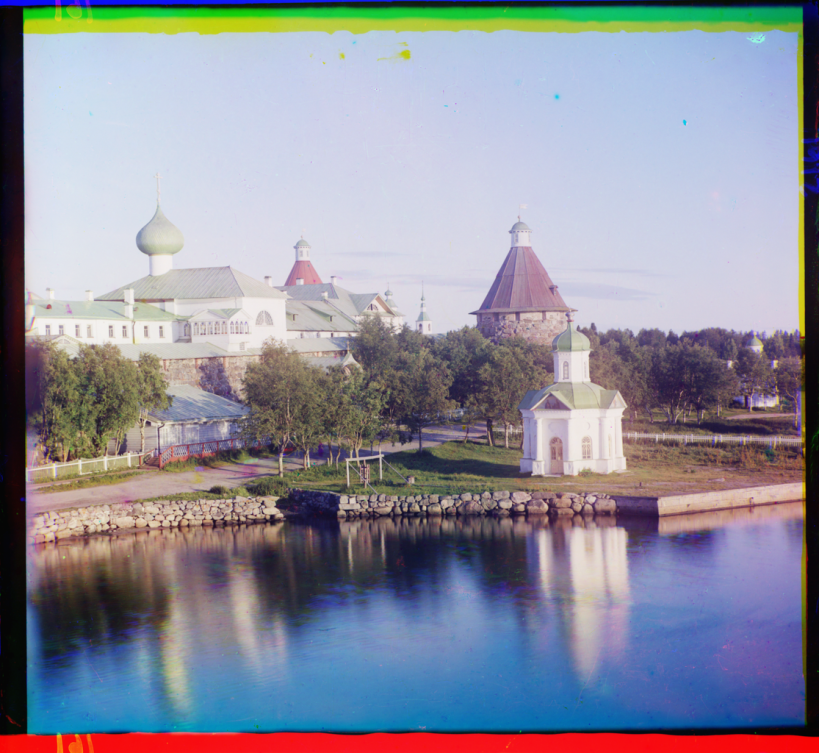
This photograph, taken by Russian photographer Sergei Prokudin-Gorskii in 1915, depicts the Solovetskii (also spelled Solovetsky) Monastery. Located in the Solovetsky archipelago (Solovki), the monastery harbors major Russian historical significance.
The first major expansion of the monastery occurred under the guidance of monk Philip Kolychev. From 1547 to 1566, Kolychev carried a series of construction projects and infrastructure improvements that solidified the monastery’s place as a fantastic feat of architecture. However, Kolychev’s political dissidence led to his execution at the hands of Ivan the Terrible – a fate which foreshadowed the monastery’s grim future.1
The 16th-century monk was one of many to meet a macabre fate at Solovki. Solovetsky Monastery was used as a prison intermittently throughout the tsarist era until 1903.2 However, in 1921, the Bolsheviks seized the monastery. By 1923, the first Soviet concentration camp was established in Solovki. 3

At first, those sent to Solovski were primarily members of the anti-Bolshevik White movement, in addition to citizens who had committed minor infractions. Over time, many members of the intelligentsia were detained here, in addition to criminals who had committed serious offenses.4
Prisoners at Solovski often endured egregious mistreatment. Accounts of torture are common – some mention prisoners being held down and eaten alive by mosquitoes. When high-status members of society like writer Maxim Gorky visited, they were shown an embellished version of camp life. Clean sheets, decent food, and humane treatment were made to seem common. In fact, when the Bolshevik government released a film called Solovki, supposedly depicting life at the camp, Soviet citizens were outraged. It appeared to them that the prisoners had more food and luxury than normal citizens. The Bolshevik government banned the film shortly thereafter.5
The camps were named Solovetsky Special-Purpose Camps, and eventually became one of the first GULAG centers. By 1939, the Solovetsky prison was shut down. Remaining inmates were sent to Siberia or executed.6
Restoration efforts have persisted since the collapse of the Soviet Union, and it now functions as a normal monastery. The Solovetsky Stone now stands as a monument in Moscow – a memorial to victims of political repression.

End Notes
- Brumfield, William, “The Solovetsky Transfiguration Monastery: From Prokudin-Gorsky to the Present” Russia Beyond, Link.
- The Solovki Encyclopedia, Link.
- Brumfield, William, “Miracle of Light: The Solovetsky Transfiguration Monastery” Russia Beyond, Link.
- Izyumova, Natalie, “MOAN,” Current Digest of the Russian Press, Link.
- Ibid.
- Ibid.
Monasteries and political prisoners — what a combination! I really appreciate how you’ve delved into the past (and “future”) of Prokudin-Gorsky’s photographs. And charting the monastery’s association with political repression — going back to Ivan the Terrible — really makes you pause.How do you think local residents regard the monastery now?
I’m so glad you found that terrific source in the Current Digest from Moskovkie novosti about the film Solovetsky Power. It’s a very compelling documentary — and it’s on YouTube! https://youtu.be/2MKp0WL8Fgk
Good job citing the source of your image. Also, I love the title of this post!
LikeLiked by 1 person
That is such a crazy history for a monastery! I was really interested in this photograph after you presented it in class and I am so glad you researched it more to give us a better glimpse of what is was.
LikeLiked by 1 person
Oops can’t figure out how to edit my comment, I think it was someone else who presented this picture in class but regardless such an interesting history to it!
LikeLiked by 1 person
What a great post! While I have read a little about the history of Solovetskii Monastery during the Soviet era, I knew nothing about its past or the propaganda films it was involved in. I would suggest looking at Justin’s post about the Nilova Monastery and compare its fate to Solovetskii. This was educational and very well researched, great job.
LikeLiked by 1 person